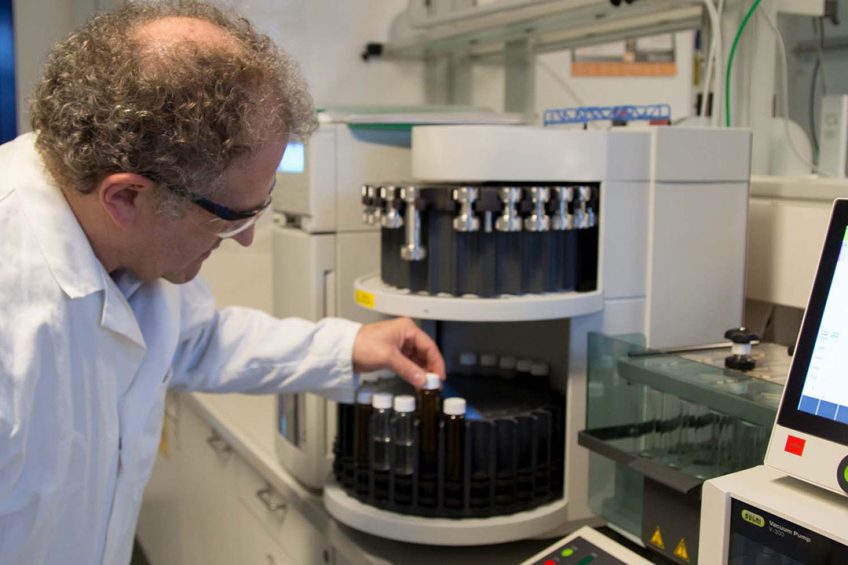New approach lessens antibiotic impact

A team of scientists of the German Leuphana University of Lüneburg has developed a variant of the antibiotic Ciprofloxacin that is broken down in the target animal and eventually excreted as inactive metabolites. Professor Klaus Kümmerer believes more biodegradable antibiotics will follow suit.
Ciprofloxacin is one of the antibiotics heavily used worldwide, especially in the livestock sector since patents have expired. As a result, it is frequently detected in the environment. “The use of Ciprofloxacin is under discussion as it may contribute to antimicrobial resistance,” says Prof Klaus Kümmerer of the Leuphana University of Lüneburg. He is at the head of a novel research: “Our scientific research with the title Benign by Design is a concept within green chemistry, which aims to design chemicals and pharmaceuticals for better functions and less environmental pollution. We started the research in November 2014 and finished it in April of 2018.” For such a ground breaking and ambitious approach, the work of several people was needed, including many PhD students. The tools and knowledge needed came from several sub disciplines on the University according to the professor: “Organic chemistry, pharmacy, environmental chemistry, computational chemistry, photochemistry and microbiology were involved.” Different parts and stages of the research were funded by the German Ministry for Education and Research, others by the Deutsche Forschungsgemeinschaft (German Science Council) and the European Union. However the most critical and risky part was funded by the Federal German Environmental Foundation.
More then 15 years ago
The research of Prof Kümmerer into Benign by Design started more then 15 years ago. At that time the goal was to demonstrate that the stability of pharmaceuticals and chemicals during application is not contradictory to environmental biodegradability. Prof Kümmerer: “Having a strong background in environmental chemistry, for me it was clear that environmental degradability alone is not enough. Degradation would not exclude the formation of stable and unwanted products of incomplete degradation. Therefore I aimed to make sure that pharmaceuticals and chemicals that may end up in the environment are completely degraded, meaning that they are fully mineralised to carbon dioxide, water and inorganic salts after their introduction into the environment.” At that time another focus of his research was the presence of pharmaceuticals in the environment. Therefore it was clear that this design for environmental biodegradability of molecules needs to be applied to pharmaceuticals too. That was also the starting point for a broader view for Prof Kümmerer.

As stable as needed
The research wanted to demonstrate that environmental mineralising of pharmaceuticals with high enough stability, i.e. low enough reactivity for application is not necessarily a contradiction. Prof Kümmerer also aimed to demonstrate that by this approach the presence of pharmaceuticals in the environment can be drastically reduced in a sustainable manner, worldwide. “We had to move with caution and took in to account possible failure, as in the beginning some large multinational companies were fighting us. But we also had plenty of people that supported and cooperated with us. Finally we succeeded and we could demonstrate that the approach works. We came up with several successful cases including chemicals, but even more important, with a new ß-blocker and two new antibiotics.” They were able to file two patents. An interested company could get a licence or buy the patents. Thereby the intellectual property is protected for many years and made sure that investment in further development and marketing can be regained after the introduction of the new antibiotics into the market according to Prof Kümmerer.
Prof Kümmerer: “Our compounds are the first ones that were explicitly designed to be as stable as needed in the treated organism and at the same time to break down only shortly before excretion, i.e. in the bladder. In addition products of this break down have much lower or no antibiotic activity and are no longer toxic. Furthermore they are biodegradable in the environment.”
The professor could prove that the compounds are as active as needed, stable enough during application and no more toxic than the compounds they can substitute. And that they have much more favourable environmental properties and that they contribute to the reduction of resistance and to reduce the pollution of water and soil. Although, there are still steps needed to develop the new compounds into a marketable pharmaceutical. Prof Kümmerer: “However, that is also a new business opportunity as intellectual property is protected and the quest of antibiotic resistance will increase in the future.” From now on the further development into a marketable drug is not dissimilar from the introduction of conventional compounds. The synthesis can be scaled up easily and this new antibiotic can be produced on a large scale.

United Nations goals
The development of other similar degradable antibiotics shouldn’t take long according to the German professor. “We have developed different approaches including re-design as well as de-novo design, both being rational approaches. Furthermore, we could identify some general rules which will be helpful for future work.” Keeping in mind that stability is not of value on it’s own, but instead thinking of which type of reactivity, i.e. life time, is needed at which stage of the life cycle of a pharmaceutical, brings new possibilities and opportunities into focus. For example new functionalists of an antibiotic and thereby new molecules linked to new patents. According to Prof Kümmerer this development will go faster and faster, as soon as we know more about it. “More and more researchers and companies will work in this area, so we will have more and more new and better pharmaceuticals including antibiotics within shorter time.”
Traditional antibiotics like penicillin and other betalactam antibiotics such as amoxicillin can serve as a good example to demonstrate that even without a targeted design it is possible to come up with active marketable compounds that are at least easily inactivated in the environment. Prof Kümmerer: “When we noticed this, it gave us much confidence for our targeted approach. Our own research showed that some are even completely mineralised, many others are at least inactivated but not completely mineralised.”
According to the German professor among other things antibiotics like ß-lactams, sulphonamides and tetracyclines, that are used a lot in the livestock sector, would be nice to be the next research item. “In fact last year we started already working on sulphonamides (no funded project yet). As we need more successful examples to demonstrate the general feasibility of our research. Knowing that addressing the quest of (aquatic) micro pollutants is one of the most important ones worldwide, as underlined in the Sustainable Development Goals #6 of the United Nations, we will continue our work.
 Beheer
Beheer







 WP Admin
WP Admin  Bewerk bericht
Bewerk bericht